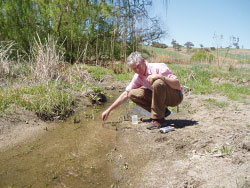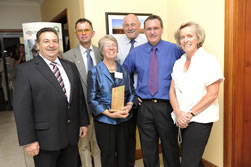Harden
Atmosphere & Weather | Biodiversity | Catchments | Resources Use
Summary of updates to Harden indicators for 2008/09.
Harden Snapshots
These "snapshot" profiles celebrate recent environmental initiatives within this LGA.
Archive of 2008 snapshots for Harden.
2009 Snapshots
1. Targeting Hotspots – the Jugiong Creek Salinity and Water Quality Project
2. Community Stream Monitoring – An Award Winner
3. Improving Land Capability through Innovation
Targeting Hotspots – the Jugiong Creek Salinity and Water Quality Project
Jugiong Creek is one of 18 priority sub-catchments that the Murrumbidgee Catchment Management Authority (CMA) has identified as contributing high concentrations of salinity, nutrients and turbidity into the Murrumbidgee River.

Harden Murrumburrah Landcare member
Mal Hufton water testing at Jugiong Creek
Photo: Murrumbidgee CMA
As part of the Jugiong Creek Salinity and Water Quality Project, best management practices were introduced to reduce salinity and sediment entering the Murrumbidgee River in priority sub catchments within the Jugiong Creek catchment. These best management practices are consistent with actions listed within the Murrumbidgee Catchment Action Plan.
Murrumbidgee CMA is supporting existing partnerships within the local community including Harden Murrumburrah Landcare Group and local land managers, Harden Shire Council, New South Wales (NSW) Department of Primary Industries and local consultants. The NSW Department of Natural Resources provided technical expertise, community knowledge and experience to further develop and manage this project’s implementation.
This successful project has:
- Targeted land managers in hotspot sub-catchments with incentives to implement best management practices in identified parts of the landscape.
- Used incentive payments to:
- protect and enhance regionally endangered, vulnerable, depleted and well retained communities for recharge control;
- establish native vegetation for recharge control;
- mitigate severe and moderate saline discharge sites with fencing and salt-tolerant vegetation;
- protect and enhance river/creek native riparian vegetation;
- establish native riparian vegetation on targeted rivers/creeks;
- control gully erosion on targeted rivers/creeks;
- manage existing native and introduced perennial pastures to reduce salt load; and
- manage established perennial pastures for recharge control through the use of stewardship payments. - Enhanced the skills, knowledge and capacity of land managers to plan and undertake natural resource management works.
- Monitored, evaluated and recorded land management change.
- Mapped current land management within the sub-catchments.
Community Stream Monitoring – An Award Winner
Harden’s Community Stream Monitoring project won the Landcare Community Group Award as part of the Murrumbidgee Regional Landcare Awards in 2009.

Tony Catanzariti (MLC), Mark O’Connor (HMLG),
Donna Ried (Binalong LG), John Williams (MP),
Peter Golding (HMLG),
Louise Hufton
(Murrumbidgee
CMA)
Photo courtesy of Murrumbidgee CMA
“This award recognises an outstanding community group that has adopted sound land management practised on public or private land and is working towards sustainable landuse on behalf of the community.”
Over the last four years, the Harden Murrumburrah Landcare Group has undertaken monthly surveys of stream salinity in Cunningham Creek. This was part of the “Community Stream Sampling Framework” project supported by the Bureau of Rural Sciences, Harden Shire Council and the Murrumbidgee Catchment Management Authority (CMA). The surveys have increased the quality of data available on Cunningham Creek and have subsequently allowed for the establishment of effective salinity management projects in the Jugiong Creek catchment, which will eventually lead to improved water quality.
A final report for this project was presented to the community in August 2009. A copy of the report is available from the Harden office of Murrumbidgee CMA within Harden Shire Council. The community has decided to continue the monthly surveys of Cunningham Creek as all the streamflow data collected to date has been under drought conditions, and additional wet weather streamflow data will further enhance the success of this project.
Improving Land Capability through Innovation
Farmers within the Harden Local Government Area are realising the benefits of retaining crop stubble on their land after harvesting. The Harden Murrumburrah Landcare Group (HMLG) is investigating these benefits through trial sites, as well as the challenges farmers may face when sowing new crops into heavy stubbles.
This project is managed by Murrumbidgee Landcare Inc., funded by Woolworths Sustainable Farms Drought Program and supported by New South Wales Department of Primary Industries and Murrumbidgee Catchment Management Authority.
This innovative project compares a range of stubble management practices for benefits in conserving soil moisture and structure, providing protective soil cover and improving crop productivity. The current management of cereal crop stubble is to graze the paddock after harvest, and then burn the residual prior to sowing any new crops. While grazing is the most common method of stubble management, some operators are testing a no-livestock system. This project has been running since 2005, and a number of methods of stubble management have been investigated including biological products, mechanical treatments, and other techniques to remove the need to burn stubble.
Other strategies include practical methods that are being tested and adopted across the region, such as:
- Harvesting at a lower height to reduce straw length and improve flow of residue through sowing cultivators,
- Mulching with a disc chain or Coolamon harrows soon after harvest to chop and flatten straw, speeding up residue breakdown,
- Leaving stubble standing and sowing with a cultivator designed to handle stubble, and
- Heavy grazing to reduce stubble load.
Five farmers in the HMLG are participating in this project, implementing a range of different stubble management practices or treatments in their paddock to compare normal farm practice with other treatments selected by each Landcare group.
Stubble load assessments are undertaken at each site, as well as post harvest soil moisture measurements. The HMLG hopes to find that testing the pre-sowed soil will show differences in moisture conservation levels.
Further monitoring of these paddock demonstration sites throughout the year will give an indication of the best stubble management practices.. The project will also allow farmers to fine-tune their cropping systems to make better use of stubbles.
